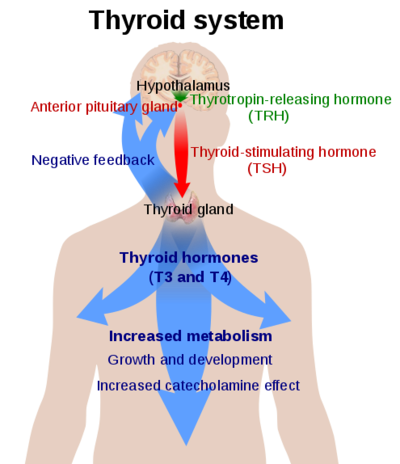Sandbox Reserved 1792
From Proteopedia
(Difference between revisions)
| Line 6: | Line 6: | ||
== Introduction == | == Introduction == | ||
| - | '''Thyroid Stimulating Hormone Receptor (TSHR)''' is a type of [https://proteopedia.org/wiki/index.php/GPCRs G-Protein Coupled Receptor (GPCR)] found in human thyroid follicles. It is activated by the [https://en.wikipedia.org/wiki/Thyroid-stimulating_hormone Thyroid Stimulating Hormone (TSH)] which is known as thyrotropin. Activation of TSHR is neccessary for activating a signaling pathway for the production of thyroid hormones such as [https://en.wikipedia.org/wiki/Triiodothyronine | + | '''Thyroid Stimulating Hormone Receptor (TSHR)''' is a type of [https://proteopedia.org/wiki/index.php/GPCRs G-Protein Coupled Receptor (GPCR)] found in human thyroid follicles. It is activated by the [https://en.wikipedia.org/wiki/Thyroid-stimulating_hormone Thyroid Stimulating Hormone (TSH)] which is known as thyrotropin. Activation of TSHR is neccessary for activating a signaling pathway for the production of thyroid hormones such as [https://en.wikipedia.org/wiki/Triiodothyronine T<sub>3</sub>] and [https://en.wikipedia.org/wiki/Thyroid_hormones T<sub>4</sub>] |
[[Image:Thyroid System.png|400 px|left|thumb|An overview of the Thyroid System source: [https://en.wikipedia.org/wiki/Thyroid_hormones Thyroid Hormones]]] | [[Image:Thyroid System.png|400 px|left|thumb|An overview of the Thyroid System source: [https://en.wikipedia.org/wiki/Thyroid_hormones Thyroid Hormones]]] | ||
== Structure== | == Structure== | ||
| - | <scene name='95/952720/Structure_overview/2'>TSHR has 3 main domains</scene>: Leucine Rich Region Domain (coral), the hinge region (blue-purple), and the transmembrane region. The (rainbow). The leucine rich region domain is located on the outside of the cell. This is where TSH will bind. The hinge region is also extracellular. Conformational changes in this region are responsible for the switch between the [[active vs inactive state]]. | + | TSHR forms a complex with TSH and G<sub>s</sub> proteins. This is called the TSH-TSHR-G<sub>s</sub> Complex. |
| + | <scene name='95/952720/Structure_overview/2'>TSHR has 3 main domains</scene>: Leucine Rich Region Domain (coral), the hinge region (blue-purple), and the transmembrane region. The (rainbow). The leucine rich region domain is located on the outside of the cell. This is where TSH will bind. The hinge region is also extracellular. Conformational changes in this region are responsible for the switch between the [[active vs inactive state]]. Finally, the transmembrane region is located within the plasma membrane. Its function is to hold the receptor into the membrane. This domain is also bound to the G-proteins. | ||
=== Transmembrane Region=== | === Transmembrane Region=== | ||
<scene name='95/952720/Transmembrane_region/1'>Transmembrane Region</scene> (<scene name='95/952720/Transmembrane_region_top-view/1'>top-view</scene>) | <scene name='95/952720/Transmembrane_region/1'>Transmembrane Region</scene> (<scene name='95/952720/Transmembrane_region_top-view/1'>top-view</scene>) | ||
Revision as of 16:28, 24 March 2023
| This Sandbox is Reserved from February 27 through August 31, 2023 for use in the course CH462 Biochemistry II taught by R. Jeremy Johnson at the Butler University, Indianapolis, USA. This reservation includes Sandbox Reserved 1765 through Sandbox Reserved 1795. |
To get started:
More help: Help:Editing |
Thyroid Stimulating Hormone Receptor (TSHR)
| |||||||||||
References
- ↑ Hanson, R. M., Prilusky, J., Renjian, Z., Nakane, T. and Sussman, J. L. (2013), JSmol and the Next-Generation Web-Based Representation of 3D Molecular Structure as Applied to Proteopedia. Isr. J. Chem., 53:207-216. doi:http://dx.doi.org/10.1002/ijch.201300024
- ↑ Herraez A. Biomolecules in the computer: Jmol to the rescue. Biochem Mol Biol Educ. 2006 Jul;34(4):255-61. doi: 10.1002/bmb.2006.494034042644. PMID:21638687 doi:10.1002/bmb.2006.494034042644
Student Contributors
- Alex Kem
- Grace Lane

